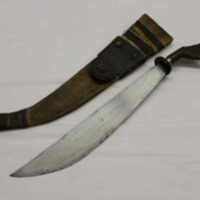Fish Trap (Ifugao)
Text
Pear-shaped, worked as a two-way braid, in which vertical, passive bamboo strips are braided with rattan strips parallel to the base in a plain weave. The upper opening has an outside diameter of about 9 cm, from here the wall continues conically inwards (holga) and extends into about the middle of the trap. The ends of the bamboo strips of the inner cone are pointed to prevent the animals from escaping after they have swum through the smaller cone into the trap. At the lower end, the opening of the trap (diameter: 4.5 cm) can be closed with a lid, which is missing in the present piece. Reuse shows signs of use.
According to Lambrecht (1957) the Mayawyaw (subgroup of the Ifugao) use the gubu trap to catch crayfish in stagnant waters; the bait is attached to the inside of the lid. With the closed lid facing down, the fish trap is placed vertically in the bottom of the water. According to the classification of Lips (1927: 130), the trap is a real trap from the group of snare traps.
Lit .: Lambrecht, F .: The Mayawyaw Ritual: Hunting and its Ritual. In: J.East Asiatic Studies. Vol6, N.1, 1957: 1-28. Lips, J .: Trap system of primitive peoples. In: Ethnologica, Vol III, 1927: 123-282
Share this



